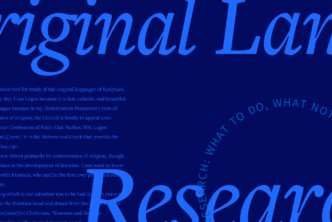This post will offer a fresh perspective on the grammar of a much-debated, and theologically loaded, verse in the Hebrew Bible:
שְׁמַע יִשְׂרָאֵל יְהוָה אֱלֹהֵינוּ יְהוָה אֶחָד
Listen, Israel! YHWH is our God. YHWH is the one.
My interpretation is a nuanced version of the translation we see in the NLT:
Listen, O Israel! The Lord is our God, the Lord alone.
Many commentators have also arrived at the same conclusion, though they use lines of reasoning that differ from what I will employ here. I use the verse as a test case to demonstrate the value of linguistic reasoning in reading the Bible. Modern linguistics provides a tremendous variety of tools that can be used to understand the biblical text. However, such tools will only provide value if we know how to use them; using them involves thinking like a linguist. Here, I illustrate how to think about the issues involved from a specifically linguistic perspective.
More concretely, I will utilize theories on “definiteness” and “bare singulars” to exegete the last line of this verse—as an illustration of how to approach the biblical text as a linguist and to demonstrate the value of modern linguistic tools to aid us in exegeting the Word.1
What is modern linguistics?
Linguistics is the scientific study of language. Noam Chomsky is said to be the “father of modern linguistics,” and the various linguistic theories on the market today are pretty much all an adoption of, revision of, or reaction to his ideas. His publication of Syntactic Structures in 1957 brought a level of systematization and precision to language analysis that had not been widely adopted up until that point. Today, we have data-driven, systematic, and precise analyses of a large variety of linguistic phenomena in hundreds of languages, and this is in large part due to his influence.
What does this discipline of linguistics have to do with our understanding of the Bible? The biblical text has been the subject of a tremendous amount of investigation and rigorous research. Such scrutiny has, of course, led to a heightened understanding of God’s Word. At the same time however, a tradition has developed not only in what the Bible says but also in how to read and analyze the text. Tradition is extremely valuable and is the bedrock of innovation, yet holding to tradition uncritically and as a static axiom may also lead to stagnation in our understanding of the biblical text.
The same can be said for how we read the Bible and engage in exegesis. If the same methods of interpretation are employed, we will often get the same results. Linguistics offers a novel framework for approaching language, a framework that has been underutilized in biblical studies. As an academic discipline, linguistics is still in its infancy, particularly as compared to something like theology; but significant advances have been made. We know far more now about how language works than we did sixty-five years ago when Syntactic Structures was first published. Genuine progress has been made especially in the following areas:
- Syntax (the structure of language)
- Semantics (the meaning of language)
- The syntax–semantics interface (how the two interact),
These are all areas of language with great relevance to exegesis. Doing linguistics well involves careful analysis of data, approaching the data systematically, and describing the data precisely. We will go through each of these categories with our sample verse of Deuteronomy 6:4, focusing on the phrase יְהוָה אֶחָד, to show how we can come to a better understanding of the text using linguistics.
Analyzing the data
A fundamental principle of scientific analysis is isolating variables, which means that experiments should be designed so that only one thing changes between test runs. This allows us to see what happens when the variable in question changes. The correlate in linguistics is to find a minimal pair. A minimal pair is a set of two data points that only differ with regard to one parameter. For example, Emmett ate the cookie is a minimal pair with Emmett ate a cookie, but it is not a minimal pair with Emmett will eat a cookie, since this last sentence has two different parameters that have changed. It may be that a change in tense is not relevant to the interpretation of the vs. a; but it also might be the case. In modern languages where we can construct novel sentences, minimal pairs are much easier to come by. In dead languages, we must search texts to find them. Thankfully, we do have some decent candidates in this case, as the following verses illustrate:
1 Chronicles 29:1
וַיֹּ֨אמֶר דָּוִ֤יד הַמֶּ֙לֶךְ֙ לְכָל־הַקָּהָ֔ל שְׁלֹמֹ֨ה בְנִ֥י אֶחָ֛ד בָּֽחַר־בּ֥וֹ אֱלֹהִ֖ים נַ֣עַר וָרָ֑ךְ
David the king said to all the assembly, “Solomon my son, the one God has chosen, is a youth and tender.”
Zechariah 14:9
וְהָיָ֧ה יְהוָ֛ה לְמֶ֖לֶךְ עַל־כָּל־הָאָ֑רֶץ בַּיּ֣וֹם הַה֗וּא יִהְיֶ֧ה יְהוָ֛ה אֶחָ֖ד וּשְׁמֹ֥ו אֶחָֽד׃
Adonai will become king over all the land. In that day, Adonai will be the (only) one, and his name will be the (only) one.
The bolded phrases are minimal pairs because they differ in only one respect. In 1 Chronicles 29:1, we see that אֶחָד can follow a proper name like שְׁלֹמֹה (ignoring בְנִי, which is in apposition), so our pair is שְׁלֹמֹה … אֶחָד and יְהוָה אֶחָד. The only thing that differs is the name being used. Common nouns used with אֶחָד would be less relevant, since we would then be changing two parameters: both the type of noun and the name would be changing. We will come back to this example when we get to the meaning. Zechariah 14:9 is also a minimal pair, since the clauses יִהְיֶה יְהוָה אֶחָד and יְהוָה אֶחָד differ with respect to only one parameter; namely, the presence of the verb.
We must now ask what we can learn from our minimal pairs. In this case, we have two basic questions: First, what is the syntactic structure of יְהוָה אֶחָד; specifically, do we have “YHWH one” or “YHWH is one”? Because יִהְיֶה is serving as a copula in Zechariah 14:9, we know that אֶחָד can be a predicate. Second, what is the interpretation of the word אֶחָד (“one”), particularly with proper names? This is the topic of our next section.
Approaching the data systematically
Good scientists recognize that the natural world is made up of a variety of interconnected systems, and any number of parameters may be responsible for our results. We can call our “result” the interpretation of the sentence, and this interpretation arises from a number of interconnected systems. When we approach data systematically, I do not primarily mean that we approach it in an organized fashion, but that we should be thinking about “systems” as we approach the data. Language is systematic, and proper analysis involves recourse to a given language’s systems. A number of questions arises in our verse about how biblical Hebrew as a whole works, and answering these questions will help us arrive at an interpretation for our specific verse. Although the following studies do not make reference to biblical Hebrew, the theories developed in the linguistics literature are meant to be descriptions of how Language in general works,2 and so are, in theory, relevant to a wide array of languages. Some relevant questions are:
- How does the system of nonverbal predication work in biblical Hebrew?3
- How does the system of numerals, particularly the number one, work in biblical Hebrew?4
- How does the system of definiteness work in biblical Hebrew, particularly with “one”?5
Definiteness
In this section, we look at biblical Hebrew’s definiteness system more closely as an illustration of how to think systematically about our data.
I suggest the translation of “YHWH is the one” for our clause. This interprets the word אֶחָד as a predicate (in accordance with Zechariah 14:9); and my claim is that the best rendering into English includes the article, so “the one” is the meaning and not “one” (which is the usual translation). An English speaker might say, “Biblical Hebrew has an article. If that is how the clause should be interpreted, why not say יְהוָה הָאֶחָד?” This assumes that the article in Hebrew would be used in the same environment as it would in English. In other words, the two languages have a similar system for marking definiteness, and the similarity in these systems would lead to requiring the article in this particular case. The more general claim is easily proven to be false. For example, we often find the bare singular in environments where we require the definite article in English (bare singulars are interesting in their own right, and they have been investigated in Modern Hebrew, as well as many other languages).6
Ezekiel 21:8
וְהוֹצֵאתִ֥י חַרְבִּ֖י מִתַּעְרָ֑הּ וְהִכְרַתִּ֥י מִמֵּ֖ךְ צַדִּ֥יק וְרָשָֽׁע
I will bring out my sword from its sheath, and I will cut off the righteous and the wicked from you.
Ignoring the theological problem here of God destroying both the righteous and the wicked together, such an example shows that classes can be referred to with the bare singular in biblical Hebrew. In English, this meaning is expressed with the definite article. “I will cut off righteous and wicked from you” is not something that an English speaker would ever naturally say. This shows that there are some environments where the bare singular is equivalent to the English definite article. Our next question is whether we have one of those environments in our example.
Answering this question involves (at least) two considerations. First, how is אֶחָד in particular used with and without the article? Second, how is it used with proper names, which is our environment in Deuteronomy 6:4? First Chronicles 29:1 gives us answers to both questions. With regard to the first question, we see that אֶחָד without the article can be equivalent to “the one” in English. In such cases, אֶחָד and “the one” exclude all other relevant possibilities from whatever is being talked about. To say, “She is the one” is to say all other females are not. Likewise, אֶחָד in 1 Chronicles 29:1 means that all other candidates for the throne are excluded. Solomon is the one who was chosen and no one else.
Notice that understanding אֶחָד as “the one” is very different from “one,” particularly with proper names. If we were to translate 1 Chronicles 29:1 as “Solomon my son, one God has chosen,” we would infer that God has chosen more than just Solomon. He is just one of a plurality that God has chosen. Let’s compare this to the structure of the Shema. If we said, “Biden is our president. Biden is one,” we might infer from this that Biden is one of several people who can claim the title of president. And this would be true in some sense. We continue to use the title of president for past presidents as well. This is, of course, the opposite meaning of “Biden is the one” where we have now excluded everyone else from the presidency.
Although the Shema is never interpreted this way by scholars, it is, I suggest, the most natural way to read the sentence in modern English. YHWH is Israel’s God. YHWH is one (of them). We might follow with “Ba’al is also Israel’s god. He is another one of them.” This is the incorrect interpretation, and it would obviously clash with the context. Nevertheless, I argue that it is actually the interpretation that our translations most naturally suggest. (We will look below at a less natural, more theologically laden interpretation involving God’s “oneness.”)
So we have said that אֶחָד can be used without the article to refer to a unique individual, and we have seen this particularly with proper names. To bolster this interpretation, we would want to check to see if הָאֶחָד was also used like “the one” in English. Of course, the positive evidence that אֶחָד can be interpreted as “the one” is enough to consider it as a possibility in this case, but might הָאֶחָד have been clearer? It turns out this is not the case. With the article, הָאֶחָד often refers to something that is being counted, such as an ordinal number, as in Genesis 4:19:
וַיִּֽקַּֽח־ל֥וֹ לֶ֖מֶךְ שְׁתֵּ֣י נָשִׁ֑ים שֵׁ֤ם הָֽאַחַת֙ עָדָ֔ה וְשֵׁ֥ם הַשֵּׁנִ֖ית צִלָּֽה
Lemech took for himself two women. The name of the first was Ada, and the name of the second was Tsilla.
Assuming that the system of definiteness works the same in English and in Hebrew would lead to faulty conclusions about what the data suggests. Let us now hone in on how to describe our data more precisely.
Describing the data precisely
Physicists and chemists use mathematics to precisely describe what is happening in the natural world. A formula such as gravity = 9.81 m/s2 is a very precise claim that can be tested and proven to be right or wrong. In formal syntax and semantics, mathematical tools are used in order to make very precise claims about the meaning and structure of morphemes. Although I will skip the formalisms here, I will draw from some of the concepts employed in this literature.
Let’s summarize where we are before describing our interpretation in more detail. We have given a minimal pair in Zechariah 14:9 to show that אֶחָד is most likely a predicate. We then discussed what אֶחָד means with and without the article and with proper names. We saw that we have clear evidence of אֶחָד being used as “the one” with proper names where it excludes all other relevant candidates. The opposite meaning is expressed with the bare number “one” in English where we have an inference that other candidates are relevant. This leads to our translation of “YHWH is the one.” Two more questions are necessary to properly analyze the meaning of this. First, what are we excluding other candidates from in our context? Second, what kind of state is this for YHWH to be the one?
The first question is easy and is given in the previous clause.
יְהוָה אֱלֹהֵינוּ
YHWH is our God.
Israel might have had any number of other gods in the ancient world. The Shema states that Israel’s God is YHWH, but it goes further. It does not say “YHWH is one (of the many gods Israel might have).” It says “YHWH is the one (to the exclusion of all other gods).” The Shema is a clarion call for Israel to relinquish its allegiance to all other gods. YHWH is the only one.
The second question also helps us to describe this kind of state in more detail. The statement that YHWH is the one (God of Israel) is not an ontological statement about who God is. It is a statement about how Israel should view YHWH. In the context of the book of Deuteronomy, it is Moses addressing the people and saying “Listen, Israel! YHWH is our God. YHWH is the (only) one.” Moses is trying to encourage all of Israel to view YHWH as their only god.
If this kind of state is not an ontological statement about who God is, then what kind of state is it? It is a temporary state about how YHWH is viewed. In linguistics, temporary states have been called “Stage-Level Predicates” (SLPs), and there has been a tremendous amount of research on the differences between SLPs and “Individual-Level Predicates” (ILPs), or those that hold of the individual and are not temporal (see Kratzer7 for an overview). An example of an SLP is Emmett is hungry, and an ILP would be Emmett is American. Both are states, but the former is temporal and subject to change while the latter is a permanent property that cannot change. My claim is that יְהוָה אֶחָד is an SLP and not an ILP. This can be clearly seen in Zechariah 14:9 where the yiqtol verb refers to a future time when YHWH will be “the one.” The implication of this is that there was a time when YHWH was not the one, but when circumstances change in the eschaton, he will be. On that day Israel will devote their loyalty to him only.
Our verse in Deuteronomy should be interpreted in the same way. Moses is calling Israel to consider YHWH to be the one who is their God, so it is, by nature, a temporary state. It is contingent upon what Israel thinks of YHWH. If Israel considers YHWH to be their only God, they will have fulfilled Moses’s injunction. Additional linguistic evidence in support of this interpretation is the fact that ILPs are often grammatically marked in biblical Hebrew with the pronoun used as a copula, a construction which requires an ILP interpretation.8 An unambiguous ontological statement about who God is would be expressed as יְהוָה הוּא אֶחָד. For example, such a statement is made in Psalm 100:3, which says יְהוָה הוּא אֱלֹהִים “YHWH is God.” This is a statement about the nature of YHWH. He is God, and he always will be. However, he might not always be “the one” God of Israel. That is dependent upon Israel’s fidelity to YHWH.
Conclusion
The interpretation we have given of the famous Shema goes against most English translations of the verse. As we have said, the most natural way to read such a construction in English is to read it as something like “YHWH is one (of the many gods that Israel might have).” Context excludes this interpretation, so theologians have come up with a new one. Maybe יְהוָה אֶחָד is an ontological statement about who God is, about his “oneness.” We have said that this is very unlikely grammatically for several reasons; but although it is an awkward way to make a statement about God”s “unity” or “oneness” even in English, it is one of the only ways to read the typical English translations if we exclude the interpretation of YHWH being one among many of Israel’s gods (which should be excluded). And so, the doctrine of God’s “oneness” or “unity” has often been based on Deuteronomy 6:4 by theologians, ancient and modern. My interpretation suggests that Deuteronomy 6:4 says nothing about God’s unity, and it should not be used as evidence for that doctrine. Rather, it is about God’s zeal to be Israel’s only God. Moses is calling Israel to recognize YHWH as the one God of Israel.
That being said, my conclusion about the meaning of this famous verse is not itself new, as we noted at the outset. Scholars, especially Jewish ones, have recognized that the most probable meaning of the Shema is a declaration of Israel’s sole loyalty to YHWH, especially in light of similar statements made in the ancient world by people who did not believe in the existence of one god but were loyal to only one. In light of this, Moshe Weinfeld observes, after suggesting that אֶחָד “implies exclusiveness,” that “By the same token, Deut 6:4 is a kind of liturgical confessional proclamation and by itself cannot be seen as monotheistic”9 While Weinfeld arrives at this conclusion by comparing the Shema to similar statements in Sumerian, Ugaritic, and Greek, we have used linguistic tools to bolster such an interpretation.
The field of biblical studies has increasingly recognized the need to view old texts through new lenses, and recent years has seen a proliferation of new hermeneutical methods. I hope I have shown that the scientific approach to language we see in the (relatively new) field of linguistics is another valuable lens to help us see the Bible in a new light, sometimes affirming and sometimes challenging traditional readings of God’s Word.
Related articles
- What Does Yahweh Mean?
- How to Retain (and Improve) Greek and Hebrew after Seminary
- Language Learning: Empower Students to Take Hebrew and Greek
- Teaching “Sticky” Hebrew
- For more on Deuteronomy 6:4 specifically, you can check out this video on it: https://youtu.be/_DRu1aE4y-s.
- In linguistics literature, we use the notation “Language” with a capital L to speak of language in general, which is what I am referring to here. There are certain properties that Language has irrespective of the language in focus, because Language is based on certain universal cognitive principles that all humans share. The question of what aspects of Language are universal and why is a much-debated question within linguistics, but that there are at least some universals (such as each language having nouns, verbs, negation, etc.) is generally accepted.
- Isabelle Roy, Nonverbal Predication: Copular Sentences at the Syntax–Semantics Interface (Oxford: Oxford University Press, 2013).
- Hagit Borer, Structuring Sense, Vol. 1: In Name Only (Oxford: Oxford University Press, 2005).
- Christopher Lyons, Definiteness (Cambridge: Cambridge University Press, 1999).
- Edit Doron, “Bare Singular Reference to Kinds,” Semantics and Linguistic Theory 13 (August 2003): 73–90.
- Angelika Kratzer, “Stage-Level and Individual-Level Predicates,” The Generic Book, eds. Gregory N. Carlson and Francis Jeffry Pelletier (Chicago: University of Chicago Press, 1995), 125–75.
- Daniel J. Wilson, Syntactic and Semantic Variation in Copular Sentences: Insights from Classical Hebrew (Amsterdam: John Benjamins Publishing Company, 2020).
- Weinfeld, Moshe. Deuteronomy 1–11: A New Translation with Introduction and Commentary. Vol. 5. New Haven; London: Yale University Press, 2008. Print. Anchor Yale Bible.







